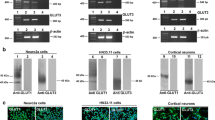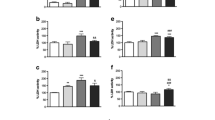Abstract
Background
The recent literature suggests that free radicals and reactive oxygen species may account for many pathologies, including those of the nervous system.
Materials and Methods
The influence of various reactive oxygen species on the rate of glutamate uptake by astrocytes was investigated on monolayers of primary cultures of mouse cortical astrocytes.
Results
Hydrogen peroxide and peroxynitrite inhibited glutamate uptake in a concentration-dependent manner. Addition of copper ions and ascorbate increased the potency and the efficacy of the hydrogen peroxide effect, supporting the potential neurotoxicity of the hydroxyl radical. The free radical scavenger dimethylthiourea effectively eliminated the inhibitory potential of a mixture containing hydrogen peroxide, copper sulphate, and ascorbate on the rate of glutamate transport into astrocytes The inhibitory effect of hydrogen peroxide on glutamate uptake was not altered by the inhibition of glutathione peroxidase, whereas the inhibition of catalase by sodium azide clearly potentiated this effect. Superoxide and nitric oxide had no effect by themselves on the rate of glutamate uptake by astrocytes. The absence of an effect of nitric oxide is not due to an inability of astrocytes to respond to this substance, since the same cultures did respond to nitric oxide with a sustained increase in cytoplasmic free calcium.
Conclusion
These results confirm that reactive oxygen species have a potential neurotoxicity by means of impairing glutamate transport into astrocytes, and they suggest that preventing the accumulation of hydrogen peroxide in the extracellular space of the brain, especially during conditions that favor hydroxyl radical formation, could be therapeutic.





Similar content being viewed by others
References
Halliwell B, Gutteridge JMC. (1989) Free Radicals in Biology and Medicine. Oxford University Press, Oxford.
Przedborski S, Donaldson D, Jakowec M, et al. (1996) Brain superoxide dismutase, catalase, and glutathione peroxidase activities in amyotrophic lateral sclerosis. Ann. Neurol. 39: 158–165.
Volterra A, Trotti D, Tromba C, Floridi S, Racagni G. (1994) Glutamate uptake inhibition by oxygen free radicals in rat cortical astrocytes. J. Neurosci. 14: 2924–2932.
Piani D, Frei K, Pfister HW, Fontana A. (1993) Glutamate uptake by astrocytes is inhibited by reactive oxygen intermediates but not by other macrophage-derived molecules including cytokines, leukotrienes or platelet-activating factor. J. Neuroimmunol. 48: 99–104.
Fonnum F. (1984) Glutamate: A neurotransmitter in mammalian brain. J. Neurochem. 42: 1–11.
Hamberger A. (1971) Amino acid uptake in neuronal and glial cell fractions from rabbit cerebral cortex. Brain Res. 31: 169–178.
Choi DW. (1992) Amyotrophic lateral sclerosis and glutamate—Too much of a good thing? New Engl. J. Med. 326: 1493–1495.
Rothman SM. (1992) Excitotoxins: Possible mechanisms of action. Ann. N.Y. Acad. Sci. 648: 132–139.
Coyle JT, Puttfarcken P. (1993) Oxidative stress, glutamate, and neurodegenerative disorders. Science 262: 689–695.
Sorg O, Magistretti PJ. (1991) Characterization of the glycogenolysis elicited by vasoactive intestinal peptide, noradrenaline and adenosine in primary cultures of mouse cerebral cortical astrocytes. Brain Res. 563: 227–233.
Stoyanov T, Martin JL, Magistretti PJ. (1988) VIP binding sites in primary cultures of astrocytes. Eur. J. Neurosci. S1: 111–110.
Bradford MM. (1976) A rapid and sensitive method for the quantitation of microgram 439 quantities of protein using the principle of protein-dye binding. Ann. Biochem. 72: 248254.
Grynkiewicz G, Poenie M, Tsien RY. (1985) A new generation of Ca2+ indicators with greatly improved fluorescence properties. J. Biol. Chem. 260: 3440–3450.
Williams DA, Fogarty KE, Tsien RY, Fay FS. (1985) Calcium gradients in single smooth muscle cells revealed by the digital imaging microscope using fura-2. Nature 318: 558–561.
Qiu Z, Parsons KL, Gruol DL. (1995) Interleukin-6 selectively enhances the intracellular calcium response to NMDA in developing CNS neurons. J. Neurosci. 15: 6688–6699.
Gruol DL, Curry JG. (1995) Calcium signals elicited by quisqualate in cultured Purkinje neurons show developmental changes in sensitivity to acute alcohol. Brain Res. 673: 1–12.
Greenwald RA, Moy WW. (1979) Inhibition of collagen gelation by action of the superoxide radical. Arthritis Rheum. 22: 251–259.
Royall JA, Ischiropoulos H. (1993) Evaluation of 2′,7′-dichlorofluorescin and dihydrorhodamine 123 as fluorescent probes for intracellular H2O2 in cultured endothelial cells. Arch. Biochem. Biophys. 302: 348–355.
DeMaster EG, Quast BJ, Redfern B, Nagasawa HT. (1995) Reaction of nitric oxide with the free sulfhydryl group of human serum albumin yields a sulfenic acid and nitrous oxide. Biochemistry 34: 11494–11499.
Koppenol WH, Moreno JJ, Pryor WA, Ischiropoulos H, Beckman JS. (1992) Peroxynitrite, a cloaked oxidant formed by nitric oxide and superoxide. Chem. Res. Toxicol. 5: 834–842.
Ueno S, Sugiyama M, Susa N, Furukawa Y. (1995) Effect of dimethylthiourea on chromium (VI)-induced DNA single-strand breaks in Chinese hamster V-79 cells. Mutat. Res. 346: 247–253.
Halliwell B, Gutteridge JMC. (1989) Protection against oxidants in biological systems: The superoxide theory of oxygen toxicity. In: Halliwell B, Gutteridge, JMC (eds). Free Radicals in Biology and Medicine. Oxford University Press, Oxford, pp. 86–187.
Vanella A, Campisi A, Castorina C, et al. (1991) Antioxidant enzymatic systems and oxidative stress in erythrocytes with G6PD deficiency: Effect of deferoxamine. Pharmacol. Res. 24: 25–31.
Tappel AL. (1978) Glutathione peroxidase and hydroperoxides. Methods Enzymol. 52: 506–513.
Devesa A, O’Connor JE, Garciá C, Puertes IR, Viña JR. (1993) Glutathione metabolism in primary astrocyte cultures: Flow cytometric evidence of heterogeneous distribution of GSH content. Brain Res. 618: 181–189.
Yudkoff M, Pleasure D, Cregar L, Lin ZP, Nissim I, Stern J. (1990) Glutathione turnover in cultured astrocytes: Studies with [15N]glutamate. J. Neurochem. 55: 137–145.
Kiechle FL, Malinski T. (1993) Nitric oxide. Biochemistry, pathophysiology, and detection. Am. J. Clin. Pathol. 100: 567–575.
Lewis RS, Deen WM. (1994) Kinetics of the reaction of nitric oxide with oxygen in aqueous solutions. Chem. Res. Toxicol. 7: 568–574.
McCord JM, Fridovich I. (1969) Superoxide dismutase. An enzyme function for erythrocuprein (hemocuprein). J. Biol. Chem. 244: 6049–6055.
Gutteridge JMC. (1993) Invited review: Free radicals in disease processes: A compilation of cause and consequence. Free Radic. Res. Commun. 19: 141–158.
Halliwell B, Gutteridge JMC. (1984) Oxygen toxicity, oxygen radicals, transition metals and disease. Biochem. J. 219: 1–14.
Cheeseman KH, Slater TF. (1993) Free radicals in medicine. Br. Med. Bull. 49: 479–724.
Szent-Gyorgyi A. (1978) The living state and cancer. Ciba Found. Symp. 67: 3–18.
Moyer VD, Cistulli CA, Vaslet CA, Kane AB. (1994) Oxygen radicals and asbestos carcinogenesis. Environ. Health Persped. 102(Suppl. 10): 131–136.
Wei H. (1992) Activation of oncogenes and/or inactivation of anti-oncogenes by reactive oxygen species. Med. Hypotheses 39: 267–270.
Downey JM. (1990) Free radicals and their involvement during long-term myocardial ischemia and reperfusion. Annu. Rev. Physiol. 52: 487–504.
Ransohoff J. (1978) Free radicals in cerebral ischemia. Stroke 9: 445–447.
Johnson KJ, Weinberg JM. (1993) Postischemic renal injury due to oxygen radicals. Curr. Opin. Nephrol. Hypertension 2: 625–635.
Chiueh CC, Gilbert DL, Colton CA. (1994) The Neurobiology of NO and OH. The New York Academy of Sciences, New York, Vol. 738.
Gutteridge JMC. (1994) Hydroxyl radicals, iron, oxidative stress, and neurodegeneration. Ann. N.Y. Acad. Sci. 738: 201–213.
Halliwell B. (1992) Reactive oxygen species and the central nervous system. J. Neuro-chem. 59: 1609–1623.
Shinar E, Navok T, Chevion M. (1983) The analogous mechanisms of enzymatic inactivation induced by ascorbate and superoxide in the presence of copper. J. Biol. Chem. 258: 14778–14783.
Holmberg P. (1984) The physics and chemistry of free radicals. Med. Biol. 62: 68–70.
Grisham MB. (1995) Interaction between nitric oxide and superoxide: Role in modulating leukocyte adhesion in the postischemic microvasculature. Transplant. Proc. 27: 2842–2843.
Huie RE, Padmaja S. (1993) The reaction of NO with superoxide. Free Radic. Res. Commun. 18: 195–199.
Squadrito GL, Pryor WA. (1995) The formation of peroxynitrite in vivo from nitric oxide and superoxide. Chemico-Biol. Int. 96: 203–206.
Trotti D, Rossi D, Gjesdal O, et al. (1996) Peroxynitrite inhibits glutamate transporter subtypes. J. Biol. Chem. 271: 5976–5979.
Preclik G, Stange EF, Ditschuneit H. (1992) Limited utilization of exogenous arachidonic acid by the prostaglandin cyclooxygenase in gastric mucosa: The role of protein binding, glutathione peroxidase, and hydrogen peroxides. Prostaglandins 44: 177–197.
Chaudière J, Wilhelmsen EC, Tappel AL. (1984) Mechanism of selenium-glutathione peroxidase and its inhibition by mercapto-carboxylic acids and other mercaptans. J. Biol. Chem. 259: 1043–1050.
Scott MD, Wagner TC, Chiu DT. (1993) Decreased catalase activity is the underlying mechanism of oxidant susceptibility in glucose-6-phosphate dehydrogenase-deficient erythrocytes. Biochim. Biophys. Acta 1181: 163–168.
Volterra A, Trotti D, Cassutti P, et al. (1992) High sensitivity of glutamate uptake to extracellular free arachidonic acid levels in rat cortical synaptosomes and astrocytes. J. Neurochem. 59: 600–606.
Yu ACH, Chan PH, Fishman RA. (1986) Effects of arachidonic acid on glutamate and γ-aminobutyric acid uptake in primary cultures of rat cerebral cortical astrocytes and neurons. J. Neurochem. 47: 1181–1189.
Stella N, Tencé M, Glowinski J, Prémont J. (1994) Glutamate induces the release of arachidonic acid by interacting with an atypical metabotropic receptor present on mouse brain astrocytes. Renal Physiol. Biochem. 17: 153–156.
Rees R, Smith D, Li TD, et al. (1994) The role of xanthine oxidase and xanthine dehydrogenase in skin ischemia. J. Surg. Res. 56:162–167.
McCord JM. (1985) Oxygen-derived free radicals in postischemic tissue injury. New Engl. J. Med. 312: 159–163.
Ogata T, Nakamura Y, Tsuji K, Okumura H, Kataoka K, Shibata T. (1996) Role of aspartate in ischemic spinal cord damage. J. Or-thopaed. Res. 14: 504–510.
Duffy S, McVicar BA. (1996) In vitro ischemia promotes calcium influx and intracellular calcium release in hippocampal astrocytes. J. Neurosci. 16: 71–81.
Mitani A, Yanase H, Namba S, Shudo M, Kataoka K. (1995) In vitro ischemia-induced intracellular Ca2+ elevation in cerebellar slices: A comparative study with the values found in hippocampal slices. Acta Neuropathol. 89: 2–7.
Acknowledgments
This work was supported in part by MH47680 (F.E.B., N.Y., D.L.G.), Deutscher Akademischer Austauschdienst (T.F.W.H.), and Swiss National Fund (O.S.).
Author information
Authors and Affiliations
Corresponding author
Rights and permissions
About this article
Cite this article
Sorg, O., Horn, T.F.W., Yu, N. et al. Inhibition of Astrocyte Glutamate Uptake by Reactive Oxygen Species: Role of Antioxidant Enzymes. Mol Med 3, 431–440 (1997). https://doi.org/10.1007/BF03401690
Accepted:
Published:
Issue Date:
DOI: https://doi.org/10.1007/BF03401690




